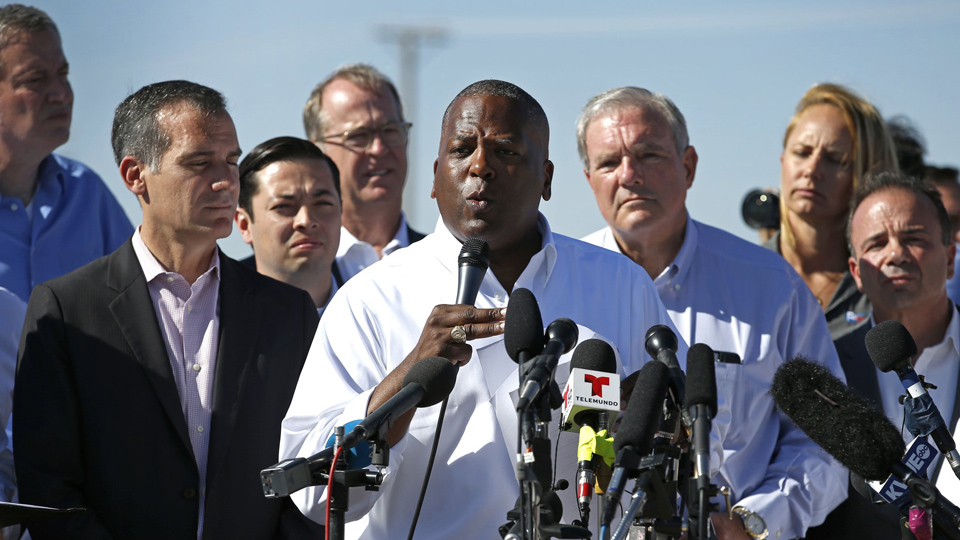
Where, exactly, is the national emergency?
Both houses of Congress have now passed appropriations legislation to fund the government for the fiscal year, and it’s become clear they will not provide President Donald Trump with the full $5.7 billion he requested to fund construction of a wall on the southern border.
Trump has been so desperate to fund his signature campaign promise that he’s gone so far as to shut down the government over it for over a month, which caused federal employees to suffer and billions of dollars worth of economic losses. In response to failing to get the money from Congress, Trump is declaring a national emergency to achieve the same ends by different means.
An emergency declaration, the president hopes, will allow him to access alternative streams of funding that will go towards funding the wall’s construction. Reuters reports the Trump administration expects to be able to allocate about $7 billion from two defense funds and a Treasury forfeiture fund as a result of an emergency declaration. This would be an extreme step that is unjustified by the facts because there is no ongoing national emergency at the southern border under any reasonable definition of the term.
Many on the right and left are unhappy with the legislation passed by Congress. Some conservative pundits and advocates are unhappy that it does not provide larger funding increases for immigration enforcement, going as far as saying that it will lead to “open borders.”
Some progressive legislators and advocates are opposing the legislation because it funds too much immigration enforcement and does little to rein in Immigration and Customs Enforcement (ICE) and Customs and Border Patrol (CBP), especially in light of recent internal criticisms of mismanagement, abuses of detainees, and policies that are being challenged in the courts for being inconsistent with domestic and international law. (The Democratic legislators in opposition, however, do not support another shutdown, and prefer that Congress pass a continuing resolution that would keep the government funded at current levels.) Trump expressed displeasure even before the legislation passed, noting earlier this week that the provisions included were “not doing the trick.”
There are both decent and terrible provisions in the legislation, and some degree of unhappiness for all parties is to be expected in any compromise legislation. What Trump appears to be most unhappy about is that Democratic legislators only agreed to give him $1.375 billion for the wall, less than a quarter of what he asked for. But is that enough to justify declaring a national emergency? And are conditions at the southern border truly an emergency? Would $4.3 billion more for additional miles of wall and fencing fix the emergency?
The facts on the ground show no sign of an emergency. The overall size of the unauthorized immigrant population has declined to its lowest level in a decade and the number of migrants being apprehended for attempting to enter the United States without authorization is lower than it has been in decades. The latest apprehension statistics from Customs and Border Protection (CBP), for January 2019, contained some revealing numbers: out of the total 47,894 apprehensions at the southwest border, 24,116 were family units (50 percent), and 5,124 were unaccompanied children (11 percent). Together, families and unaccompanied children accounted for 61 percent of all apprehensions in January. (Most hail from Central America.)
Families and children arriving at the border and asking for help are not a threat to America or a national emergency that will be remedied by a wall—they represent a humanitarian challenge that warrants a robust response to ensure the safety of people fleeing desperate situations in Central America, one of the most violent and crime-ridden regions in the world.
The American government’s meddling in the region—which has included money and weapons sent to support armed conflicts and the failed “War on Drugs”—contributed to the creation of the conditions Central American migrants face today, which include gang violence, rape, murder, and corrupt judiciary and law enforcement officials. The United States has a legal obligation to treat all asylum-seekers with respect and dignity, but considering the past many decades of U.S. policy in the region, it also bears a moral responsibility towards the Central Americans who arrive today.
In addition to the fact that there’s no need for a wall, building a wall via emergency declaration is opposed by a majority of the public. Some members of Congress in Trump’s own party have expressed doubts and reservations about the strategy, and are even actively warning against it. Trump also seems to have forgotten that the Democrats just won an election where the public overwhelmingly voted to reject the draconian immigration enforcement measures that Republicans campaigned on. Had Republicans won that debate, they’d still control Congress and could have given Trump almost anything he asked for.
Trump’s own actions belie his justification for the wall. Trump has been threatening for at least two months that he could fund the border wall on his own by declaring an emergency, but then waited to see what the compromise bill from Congress looked like before finally deciding to go for it. The fact that Trump was able to wait for so long is convincing evidence that the situation at the southwest border was never an emergency. Circumventing the appropriations process in this way also usurps the power of the purse from Congress, which is granted to it by Article I of the U.S. Constitution.
Trump’s declaration will set a precedent that could open the door for future presidential administrations to use emergency declarations to bypass Congress when they don’t get what they want. Speaker of the House Nancy Pelosi (D-CA) has already hinted at what a Democratic president might consider to be a national emergency: gun violence. Other national emergencies that could conceivably be declared include climate change, income inequality, and health care.
Make no mistake: the powers that American presidents can yield when declaring a national emergency are vast and broad, and their limits have not been clearly defined. According to research from the Brenan Center for Justice, presidential emergency powers “cover almost every imaginable subject area” and some “stand out as particularly alarming in what they authorize and in their potential for abuse.”
Trump’s declaration can be challenged, but the prospects aren’t great. Congress could attempt to terminate the national emergency by moving quickly to pass a joint resolution under the National Emergencies Act. If it passes, president Trump would then have to sign into law a joint resolution that would terminate his own national emergency, which is highly unlikely. Otherwise, Congress will need to pass a joint resolution with a veto-proof majority (two-thirds of the House and Senate), which will be nearly impossible considering the number of seats held by Republicans.
Lawsuits challenging Trump’s declaration are another avenue, and they are sure to be swift and plentiful (some are ready to go). The path to victory for a legal challenge is far from certain, however. The potential plaintiffs—which are likely to include advocacy groups, state attorneys general, and members of Congress—will have to convince a federal court that they have standing to sue. Courts are likely to view a dispute over appropriations between Congress and the executive branch as political question that they should not get involved in, making standing a difficult hurdle.
Even if we assume a plaintiff is granted standing in a federal district court, and assuming further still that the court issues a nationwide injunction, the case will eventually be decided by the Supreme Court. Once it’s before the Supreme Court, the plaintiffs will need to convince five conservative judges—two of whom were appointed by Trump—to rule against him.
In the coming days America’s democracy will face a difficult challenge thanks to a president that cares little about the norms and institutions underpinning it, and based on racist lies he’s told about dangers posed by immigrants and families seeking refuge. Members of Congress should prioritize respect for the rule of law and the separation of powers in the Constitution by passing veto-proof legislation to terminate Trump’s bogus national emergency declaration.
The above article is a reprint previously published by the Economic Policy Institute.










